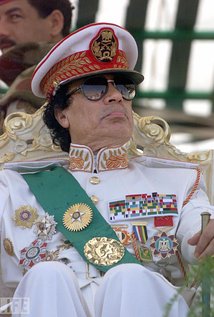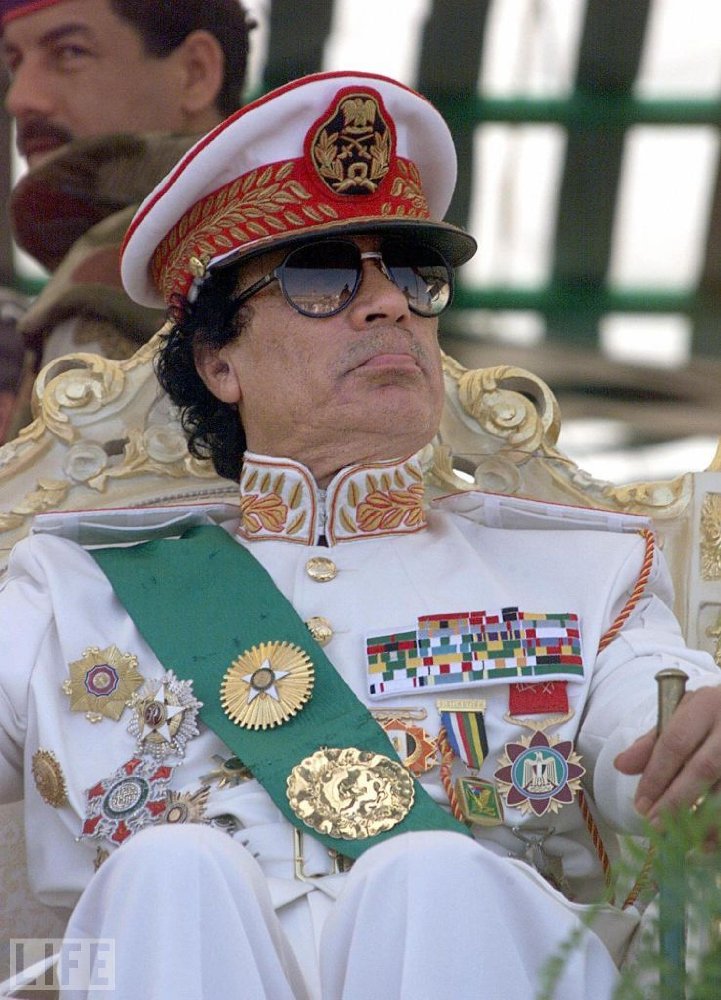Muammar Abu Meniar el-Gaddafi was born in the North African desert, south of Sirte, Libya, in 1942 (the exact date is unknown; some sources day June 1, while others say sometime in September). The son of a poor Bedouin nomad, Gaddafi lived in his family's remote desert camp until he went away to school at age 9.While a student at a secondary s...
Show more »
Muammar Abu Meniar el-Gaddafi was born in the North African desert, south of Sirte, Libya, in 1942 (the exact date is unknown; some sources day June 1, while others say sometime in September). The son of a poor Bedouin nomad, Gaddafi lived in his family's remote desert camp until he went away to school at age 9.While a student at a secondary school at Sebha, Gaddafi was inspired by the speeches of Egyptian President Gamal Abdel Nasser and became a committed Arab nationalist. Gaddafi organized his fellow students into revolutionary study groups at Sebha; he continued the practice at the University of Libya in Tripoli, where he received a history degree in 1963. Following his graduation, Gaddafi entered the Libyan Military Academy in Benghazi, where he found many of the cadets were sympathetic to his anti-Western nationalism.Commissioned into the Libyan army in 1965, he began laying groundwork for an overthrow of the Libyan monarch, King Idris, whom he considered a pawn of the Western European nations. Within four years Gaddafi took control of the army and on September 1, 1969, he seized power in a carefully planned coup. Assuming command of the government as chairman of the ruling Revolutionary Council, Gaddafi declared himself commander-in-chief of Libya's armed forces and its government, with the rank of colonel. Gaddafi soon began implementing his long-dreamed plans for Libya by nationalizing all foreign banks and oil companies and insisting on closing down all European military bases in Libya. In 1970 Gaddafi seized the private assets of Libya's Italian and Jewish residents, driving them from the country.Since assuming power, Gaddafi has given strong support to a wide variety of terrorist groups and regimes, including Iran, Iraq, Syria, Uganda, the Palestine Liberation Organization and its sub-groups, and the Irish Republican Army. Heavily supported by the Soviet Union, he fought an unsuccessful war against Egypt and a disastrous war against Chad and its ally France for control of the northern regions of the country. In an attempt to drive French forces out of the country Gadaffi sent an invasion force into Chad, only to see it annihilated by the poorly armed, minimally trained but highly motivated Chadian army. The survivors fled back to Libya, leaving behind large numbers of vehicles, equipment and weapons.Gaddafi has provoked several incidents with the US, one of which led to an American retaliatory bombing raid on his headquarters in Tripoli on April 15, 1986. Gaddafi escaped with only minor injuries but his infant daughter was killed. In 1988 Libyan intelligence agents exploded a bomb on Pan Am Flight 103 over Lockerbie, Scotland, killing over 200 people.After the September 11, 2001, terrorist attacks on the US, Gaddafi worked to improve his relationship with the West. In exchange for his help in tracking down Islamic militants his government received concessions from the West, including the easing of various restrictions placed against it due to his terrorism of the 1980s.In 2011, as part of the "Arab Spring", major civil unrest broke out in Libya aimed at removing Gaddafi from power. Gaddafi began a violent and repressive campaign against his own people and a civil war ensued, with Gaddafi forces on one side and rebels--a combination of students, ordinary people and army defectors-with air and logistical support from NATO, on the other. After an eight-month civil war, Gaddafi was captured by rebels in his hometown of Serte and soon afterward he was executed.
Show less «




